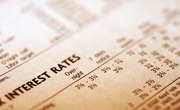How often your mortgage rate changes depends upon what kind of loan you have and the specific terms of your loan. At one extreme, a 30-year fixed-rate mortgage loan never changes; the rate is established in your original loan documents and remains there until the loan is retired. At the other extreme, a variable rate mortgage -- one where the lender has a contractual right to change the rate according to the terms of the loan -- can change as often as once a month. More often, variable rate loans offer an initial fixed-rate period, often of one year, and thereafter adjust the loan rate quarterly, semiannually or yearly.
In the 21st century, hybrid mortgage loans have become popular. These have a longer initial fixed-rate period -- usually for the first five to seven years -- then adjust yearly for the remainder of the loan.
Why Loan Rates Change
With a variable rate loan, the contractual right to make the rate adjustment is tied to a benchmark -- an external lending rate index. The three most popular indexes are:
• The current yield (set weekly) on a one-year U.S. Treasury bill.
• The District Cost of Funds Index (COFI). In the western U.S. the COFI is based on the 11th District Cost of Funds Index set by the Federal Reserve. The "Fed," as it's referred to in financial circles, sets rates up and down for policy reasons. When it wants a freer flow of borrowed funds in a stagnant or contracting economy, it sets the rate low. When it aims to resist an economy that's expanding too rapidly, it sets rates higher. The Fed meets to consider rate changes (not necessarily to make any) once a month.
• The London Interbank Offered Rate (LIBOR), which is set by polling current lending rates at major European and British banks. Rate-setting scandals and a new fee imposed on participating banks contribute to some reduction in the use of this index by U.S. lenders at the time of publication.
Contrary to popular opinion,
What to Expect
The Federal Reserve Bank of Saint Louis, one of 12 district reserve banks in the U.S., has published a useful graph, "30-Year Fixed Rate Mortgage Average in the United States." It graphs interest rates on fixed-rate mortgages, since an initial rate for a fixed-rate mortgage can be set whenever the loan document is drawn, but it gives you a good idea of how often rates in general, including the current rate on your variable rate mortgage, have changed historically. This provides a reasonably good indication of how often and to what extent they may change in the future.
The following data stand out:
• From the fall of 1981 to late 2012, the average fixed-rate mortgage declined fairly steadily from nearly 18.5 percent to slightly more than 3 percent
• From April 1971 to the fall of 1981, interest rates rose irregularly but trended upward from about 7.5 percent to nearly 18.5 percent.
• There is no 30-year period from 1981 to 2015 when a variable rate loan's interest rate wouldn't have more than doubled (or halved) from the original rate offered. Over certain periods it could quadruple.
• With few exceptions over nearly 45 years, mortgage rates changed every month.
Further study of the graph reveals more evidence of rate volatility.
References
Writer Bio
I am a retired Registered Investment Advisor with 12 years experience as head of an investment management firm. I also have a Ph.D. in English and have written more than 4,000 articles for regional and national publications.

